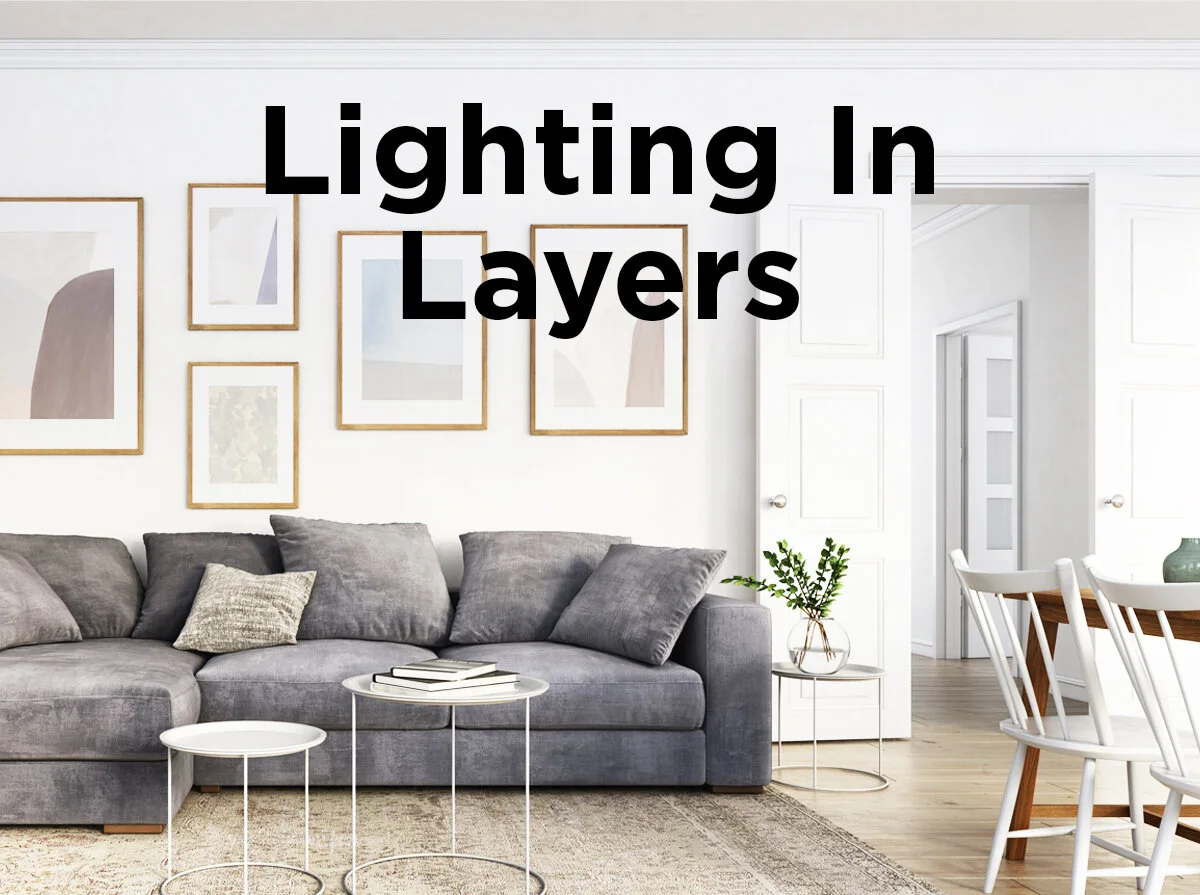Lighting Layouts
Once you buy your light fixtures, how should you arrange them? Planning your lighting ahead of time can save you a headache later. The key factor to every great lighting layout is even and consistent spacing. The nuances and tips of the most common residential fixtures are listed below.
Ceiling Mount. When do you use a ceiling or surface mounted fixture? Well, prime conditions for a flush mount fixture involve a ceiling height of less than eight feet. Hallways, closets, laundry rooms, and bathrooms are all examples of rooms that have limited space and typically low ceilings. For higher ceilings of eight to ten feet, the slight dangle of semi-flush lights become an option.
Either evenly space your lights...
... or choose a focal point.
Recessed Lights. To evenly light a room, place your first recessed light housing in the dead center of a room and evenly space out your lights from that point. If you need more light in a specific place, install your first light there; then evenly space the other lights around it. The spacing between each light fixture is your ceiling height simply divided in half. For example, with a standard 8-foot ceiling, your lights should be 4 feet away from each other. To avoid harsh shadows that make your ceiling seem lower, keep your lights about 3 feet from any wall as well. In your kitchen, set your recessed fixtures 18 to 22 inches from your cabinets to avoid unwanted shadows. To learn about what type and size of recessed light fixtures you need, check out our Recessed Lighting Buyer’s Guide.
Wall Sconces. When using wall sconces to provide general lighting in a hallway or dining room, you should space them 4 to 6 feet apart and no less than five feet from the floor. Basically, wall sconces should always be placed above shoulder height and spaced evenly. Along a staircase, they are usually placed at least three steps apart. Keep in mind the spacing can change if you have really tall walls or your sconces need to be level with your wall art.
In your bathroom, hang wall sconces on either side of the bathroom mirror at or very close to eye level. That way your face gets even lighting, eliminating unattractive shadows. A good rule of thumb is to install them between 65 to 70 inches from the floor.
Track lighting. Whether it’s general accent lighting or highlighting your wall art, tilt your track lights about 30 degrees, using the vertical from floor to ceiling as your zero-degree starting point. This prevents light from shining in anyone’s eyes and avoids distracting reflections on your prized masterpieces. Usually, you only need one fixture for each object being lit.
After you position your fixtures at the correct angle, you can determine how far your fixtures should be from your objects. First, you measure the distance from the ceiling to the center of the object. The American Lighting Association’s “Lighting Your Life” brochure has a very helpful table to guide you. Using the table listed below, mount your track lights the corresponding inches from the wall.
| Distance from wall (A to B) |
Distance from ceiling to object (B to C) |
|---|---|
| 13 Inches | 2 Feet |
| 20 Inches | 3 Feet |
| 27 Inches | 4 Feet |
| 34 Inches | 5 Feet |
| 41 Inches | 6 Feet |
From ALA's Lighting Your Life, 2012
For non-textured surfaces and walls, you can use a technique called wall washing with your track lights. Mount the track 2 to 3 feet from the wall as long as your ceiling is nine feet or less. Ceilings between 9 and 11 feet high need to have the track light mounted 3 to 4 feet from the wall. Space the fixtures the same distance apart as the track is from the wall to evenly spread out the light.
Create dramatic shadows on textured surfaces and walls, such as draperies, stone or brick, with the wall grazing method. Simply mount the track closer, about 6 to 12 inches from the wall, with the fixtures the same 6 to 12 inches apart from each other and aimed downward for a grazing effect.
Pendants. A pendant light needs to hang an average of 30 to 36 inches above the dining room table depending on how focused you want the light. Activities like playing pool require more light, so you will need to suspend your pendants a little closer, 24 to 32 inches, to minimize glare. Pendant fixtures over your kitchen counter should average a height of 40 inches from the table surface to the rim of the fixture. Add three inches for each extra foot of height for pendants reaching down from lofty ceilings to illuminate your tabletops. If your ceiling is more than eight feet high, like in the foyer or entry way of your home, you could also measure seven feet up from the floor.
Chandeliers. Typically hung over a dining room table, the diameter or width of the table minus 12 inches is the maximum chandelier diameter you should consider, without overwhelming your space. Adding a chandelier to your foyer requires a comparison of the fixture’s width in inches to the diagonal measurement of the room in feet. A good rule of thumb is your average chandelier should hang no lower than eight feet from the floor.
You can learn about lighting specific areas of your home in our home lighting section or discover how to layer light in any room with this post. If you have more questions, need advice about a tricky area to light, or suggestions for hassle-free lighting layouts, leave your comment in the area below. Find more ideas and tips on our Facebook, Twitter, LinkedIn, or Pinterest. You can also call our 1000Bulbs staff during normal business hours for easy and insightful lighting solutions.








